California is a state of staggering scale and breathtaking diversity, making it an unparalleled destination for anyone passionate about the outdoors and rich cultural experiences. With nine national parks, over 800 miles of stunning coastline offering countless access points, and twelve distinct geographical regions, California truly is a giant playground.
My own love for outdoor activities—hiking, biking, paddling, diving, and more—naturally drew me to explore this vast state further. While I’ve spent years enjoying the eastern Sierra Nevada, I know the real magic of California lies just a road trip away from its coasts, bustling cities, and the incredible landscapes of the west side of the Sierra. For a journey that perfectly blends the iconic coast, majestic mountains, vibrant cities, and deep cultural connections, join me on the California Road Trip I recently completed.
This adventure promises a mix of natural wonders, unique urban experiences, and opportunities to connect with local communities and their stories. From the fog-kissed hills of San Francisco to the underwater world of Monterey Bay, the dramatic cliffs of Big Sur, and the towering giants of Sequoia and Kings Canyon, this itinerary is designed to immerse you in the varied soul of the Golden State. Pack your bags and get ready to explore the incredible tapestry that is California. Let’s dive into the details of each stop.
Stop 1: San Francisco
San Francisco effortlessly turns even the most dedicated nature lover into a city enthusiast. It masterfully combines the sophistication and energy of a world-class metropolis with immediate access to stunning natural landscapes. This unique blend is precisely why San Francisco holds a special place in my heart and served as the perfect starting point for my California Road Trip. Here are the highlights of my time there.
Kayak or Paddleboard San Francisco Bay
While the views of San Francisco Bay from the shore are undeniably spectacular, the most immersive way to experience its grandeur is by getting out on the water itself. My trusty paddleboard accompanied me on this journey, and I couldn’t resist putting its seaworthiness to the test with a refreshing morning session on the bay. Launching from McCovey Cove, conveniently located near Oracle Park (home of the San Francisco Giants), offers fantastic perspectives of the downtown skyline and Treasure Island.
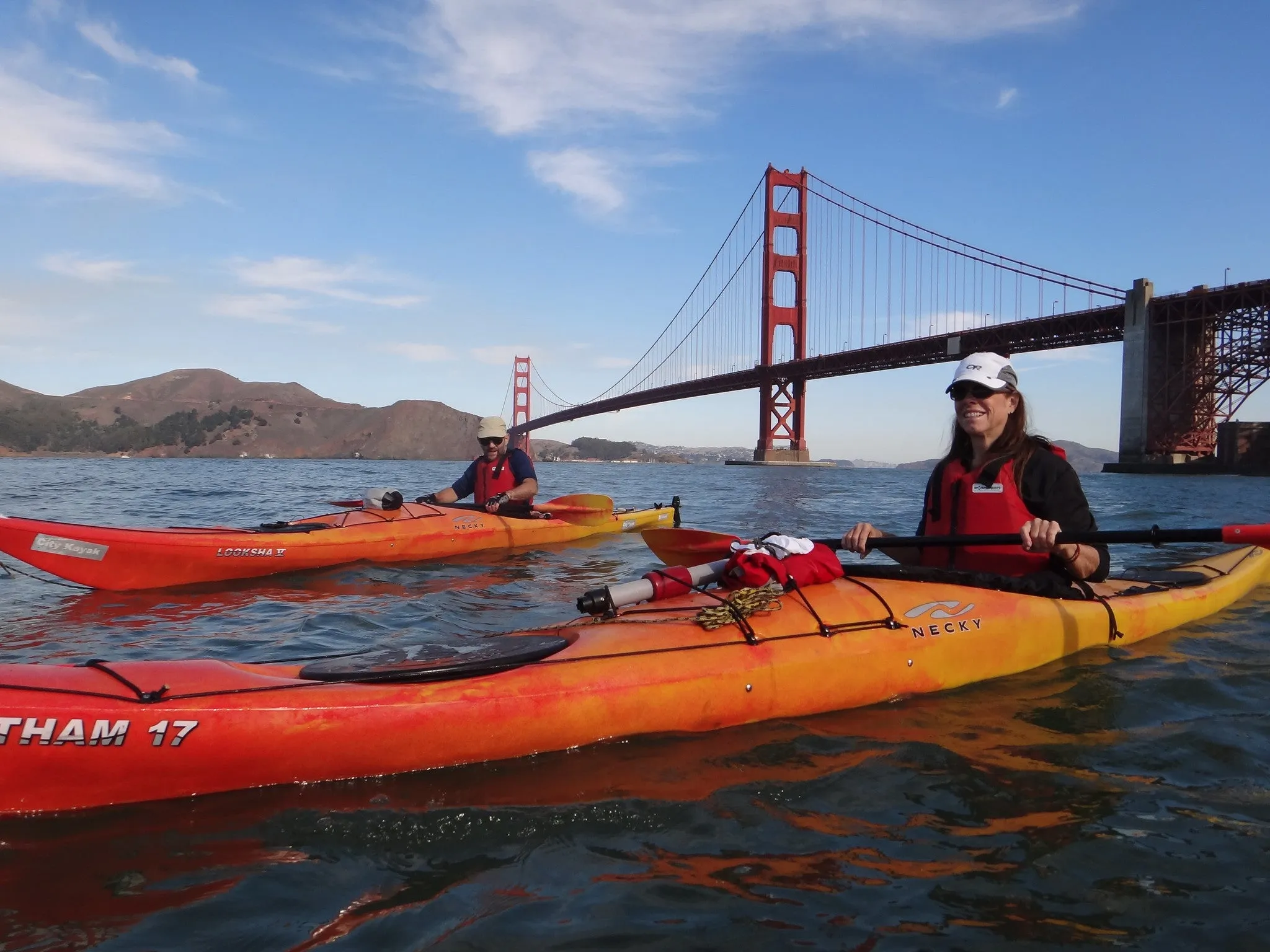
Paddleboarder enjoying morning calm in McCovey Cove San Francisco with cityscape backdrop
This launch spot is known for having calmer waters, especially in the morning before the notorious afternoon winds tend to pick up. I wasn’t alone in enjoying the perfect weather and serene conditions; a curious harbor seal even popped up to say hello during my paddle. If hauling your own board isn’t part of your summer plans, worry not. You can easily rent a kayak from local outfitters like City Kayak. They also offer guided paddle tours on select days, providing a structured way to explore the bay’s wonders.
Discover Nature Art & Creative Culture
To truly appreciate the profound connection between San Francisco and its natural surroundings, make your way to places like Wood Line in the Presidio. Here, you can admire the captivating nature art installations created by Andy Goldsworthy, whose unique work is featured in several locations across the city. These pieces beautifully integrate natural materials into the landscape, blurring the lines between art and environment.
For a more hands-on experience that connects you directly with the earth, consider signing up for a wild clay class at Artillery Ceramics. This local pottery studio hosts fascinating clay foraging workshops held at nearby nature reserves. It’s an incredible opportunity to learn about the process of gathering natural clay and then transforming it into your own artistic creation right there on the beach, surrounded by the very elements you’re working with.
Bike the Golden Gate Bridge
Yes, it’s a classic tourist activity, but biking the Golden Gate Bridge is an absolute must-do on any California Road Trip that includes San Francisco. Renting a bike and pedaling across all or even part of this iconic structure is an unforgettable experience. The route from the Presidio side to the Marin County line and back covers approximately 3.5 miles and offers unparalleled views.
During weekdays before 3 p.m., the eastern pedestrian path accommodates both bikes and foot traffic. However, after 3 p.m. on weekdays and throughout the weekend, the western pedestrian path becomes exclusively for bikes. This dedicated bike path makes navigating the bridge much easier, especially if you’re not accustomed to cycling in urban environments with mixed traffic. The sense of accomplishment and the panoramic views are well worth the pedal.
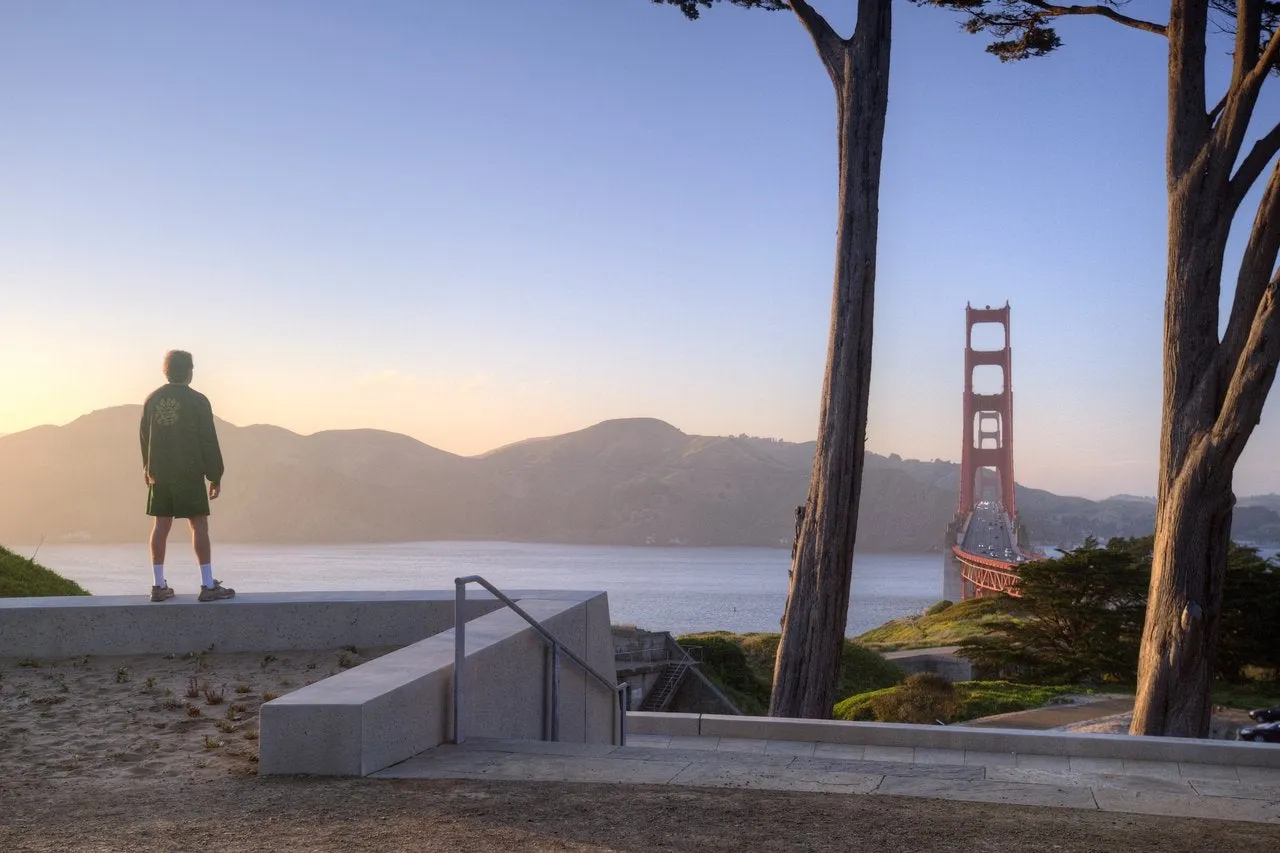 Cyclists crossing the Golden Gate Bridge San Francisco during sunset
Cyclists crossing the Golden Gate Bridge San Francisco during sunset
Sunset Views and Local Gems
Every San Francisco local has their personal favorite spot to catch the sunset, and I was fortunate that a friend was willing to share her secret. For arguably the best sunset views overlooking the Golden Gate Bridge, hike the scenic Batteries to Bluffs Trail located on the west side of the Presidio. This trail is a relatively short 2.3-mile loop, but it is steep in parts, running along the cliffside.
The Batteries to Bluffs Trail offers multiple lookout points that provide stunning vistas of the bay, the iconic bridge, and the distant Point Bonita Lighthouse across the water. As you make your way back towards the trailhead after soaking in the golden light, keep an eye out for banana slugs. These bright yellow mollusks are known to frequent the stairs leading down towards the water as dusk settles in, adding a unique wildlife encounter to your sunset experience.
San Francisco Travel Tip
For prime access to the Presidio and the Golden Gate Bridge, consider booking a stay at the Lodge at the Presidio. This charming boutique hotel boasts the distinction of being the closest lodging option to the bridge within San Francisco itself. Being located right in the heart of the Presidio means you’re within easy walking distance of numerous attractions and dining options. For exploring areas beyond comfortable walking distance, utilize Waymo. These all-electric, self-driving taxis are being piloted in the city and offer a convenient, futuristic way to get around without needing to worry about parking or traffic yourself.
Stop 2: Monterey
Leaving the bustling energy of San Francisco behind, take the scenic Highway 1 south along the coast to explore more of the stunning Central Coast. Situated about a three-hour drive south of the Bay Area, Monterey offers a distinctly more relaxed city vibe compared to its northern neighbor. It provides easy access to beautiful beaches, boasts delicious seafood dining options along the waterfront, and is home to a vibrant and welcoming diving community.
Dive into Monterey Bay’s Kelp Forests
Monterey is world-renowned for its expansive kelp forests and the incredibly diverse marine life that calls this unique ecosystem home. Creatures like playful sea otters, intricate spider crabs, colorful nudibranchs, enormous sea stars, and curious sea lions thrive here. As a passionate diver, exploring this area had been on my bucket list for years, so I was absolutely thrilled to spend a morning exploring the underwater world with Phil, a knowledgeable divemaster from Aquarius Dive Shop.
Conditions were perfect for a dive at the famous Breakwater site off San Carlos Beach. Here, we enjoyed an up-close look at the towering kelp forests and even had a friendly encounter with a sea lion during our dive. Drifting through the dense kelp, which can amazingly grow up to 175 feet tall, genuinely felt like entering another dimension.
As a diver who typically maintains perfect horizontal trim underwater, I rarely look up. Thankfully, Phil encouraged me to gaze upwards to witness the magical sight of sunlight streaming down through the swaying kelp canopy above – a truly awe-inspiring perspective on this already incredible ecosystem. If you’re not a certified diver, the Monterey Bay Aquarium offers a massive two-story kelp forest exhibit that provides a realistic underwater experience without getting wet.
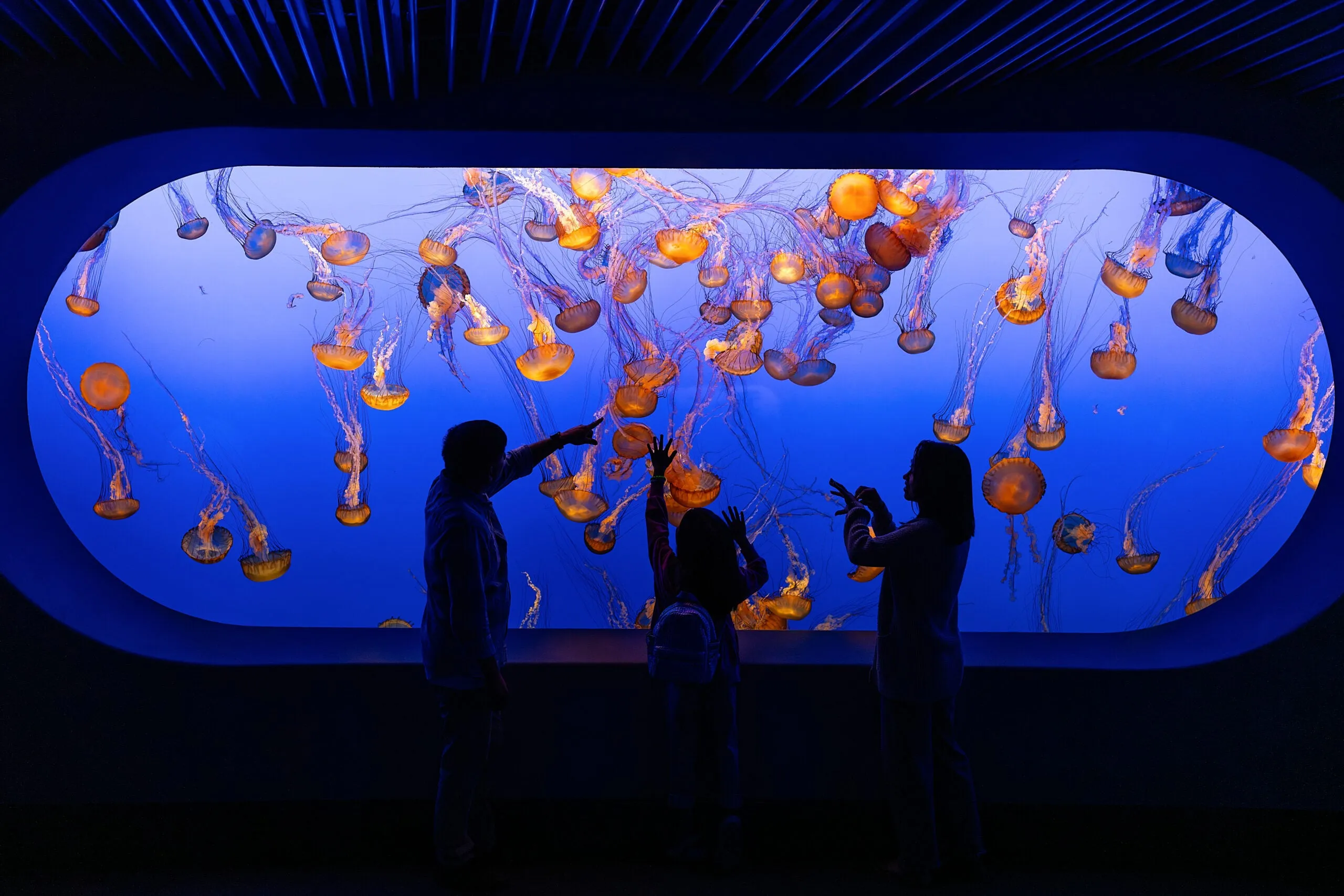 Visitors viewing the large kelp forest exhibit at the Monterey Bay Aquarium
Visitors viewing the large kelp forest exhibit at the Monterey Bay Aquarium
Taste Local Flavors: Dust Bowl Brewing
When your divemaster, a local expert, gives you a recommendation for a post-dive meal and drink, you absolutely follow it. For a satisfying dinner and a cold beer, head to the Dust Bowl Brewing Company Tap Depot. You can grab delicious fish tacos from the Wedo’s Tacos food truck, conveniently parked right at the brewery’s location. The recommended pairing of fresh fish tacos with a crisp Taco Truck Lager (a popular Dust Bowl classic) was truly outstanding and hit the spot after a morning in the water.
If you’re inclined to enjoy a second brew, Phil suggests the Therapist Imperial IPA as his go-to “dessert” beer – a testament to the quality and variety available at Dust Bowl Brewing. This spot perfectly encapsulates the laid-back, local vibe of Monterey’s waterfront area and is a great place to relax and refuel.
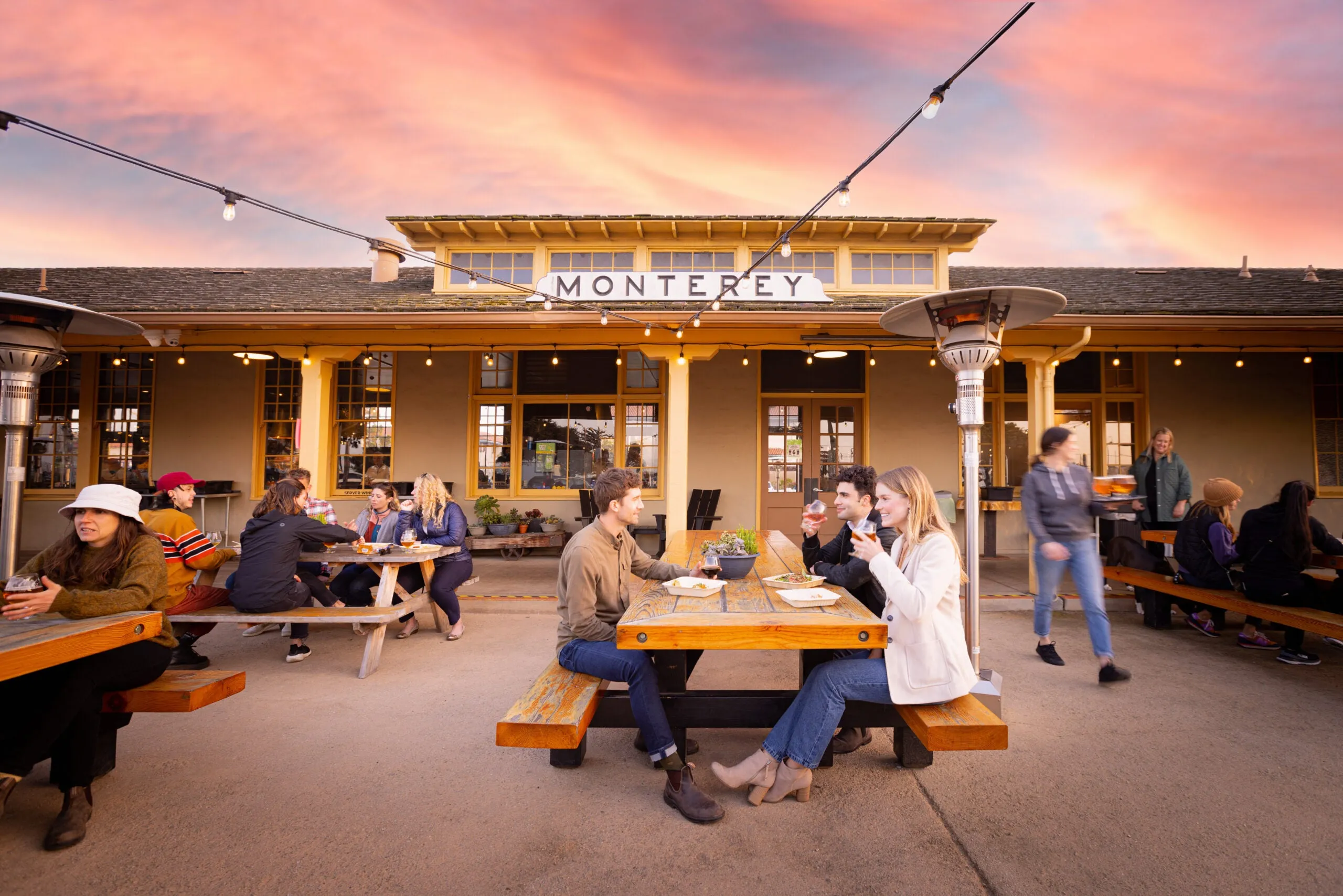 Exterior view of Dust Bowl Brewing Company’s Tap Depot location in Monterey
Exterior view of Dust Bowl Brewing Company’s Tap Depot location in Monterey
Try Aerial Arts or Climbing
While California’s abundant sunshine makes it tempting to spend every waking moment outdoors, it’s always nice to have options for when you need a break from the elements or simply want to try something different. Whenever I find myself in a new town, I love checking out local aerial arts classes. Sanctuary Climbing & Fitness, located on the northern end of the Monterey Peninsula, uniquely offers both lyra and silks classes directly within their climbing gym facility.
Top 15+ Ideas for Unforgettable Family Fun Los Angeles
Discover the Best Backpacking in Michigan – Unforgettable Trails & Adventures
Discover the Best Time to Visit Denver – A Seasonal Guide 2025
This combination creates a fantastic, energetic atmosphere and fosters a strong community feel among participants. Of course, if climbing is more your preferred way to stay active indoors, Sanctuary also provides excellent climbing facilities to explore. It’s a great spot to experience a different kind of physical activity and connect with the active local scene.
Monterey Travel Tip
For an authentic Monterey experience, securing beachfront accommodation is highly recommended. The newly renovated Monterey Beach Hotel, a Tribute Portfolio Hotel, offers a relaxed and comfortable stay with direct access to the beach. Its low-key atmosphere makes it an ideal place to unwind and recover after a day packed with adventures, whether you’ve been diving, exploring the town, or trying out a new aerial arts class.
Stop 3: Big Sur
With its breathtakingly dramatic oceanside bluffs, lush redwood-filled canyons, and seemingly endless scenic views in every direction, Big Sur has occupied a top spot on my must-visit list for years. This classic stretch of coastal California definitely lived up to its legendary hype during my visit. Driving this route is an essential part of any memorable California Road Trip itinerary focused on the coast.
Drive the Iconic Highway 1
This world-famous section of Highway 1 along the California coast, just north of the core Big Sur area, recently reopened to travelers. This timing was perfect for my trip, allowing visitors access to most of Big Sur’s key attractions once again. (Note: As of July 2024, repair work is still ongoing on a southern portion of the highway through Big Sur, specifically between 2.1 miles north of Lucia and 16.8 miles south of Dolan Point).
Make sure to allocate plenty of time for driving this unbelievably scenic stretch of coastline. Trust me, you will want to stop frequently to take countless pictures and simply marvel at the stunning, rugged landscape unfolding before you. The road twists and turns, revealing new vistas around every bend, making it a drive that is as much about the journey as the destination.
![]() The iconic Highway 1 winding along the rugged coastline of Big Sur California
The iconic Highway 1 winding along the rugged coastline of Big Sur California
Explore with a Guided Hike
While I hike frequently and feel quite comfortable navigating outdoor spaces on my own, opting for a guided hike can significantly enhance your experience, especially if you have limited time to explore. Going out with a local guide in Big Sur can help you maximize your day by revealing the area’s seasonal magic that might otherwise go unnoticed. Depending on the time of year you visit, a guide can point out mushroom foraging spots in the winter, the incredible migration of monarch butterflies in the fall, or the vibrant displays of wildflowers blooming in the spring.
For my summertime visit, my guide Patrice, a Big Sur local since 1985, was focused on spotting California condors and finding concentrations of ladybugs. Patrice’s deep connection to the area means he knows every canyon along the coast and has a lifetime of fascinating stories to share. As we drove along Highway 1 towards the Tan Bark Trail, he pulled over to show me a specific rocky crag where he frequently spots majestic condors. The population of these incredible birds has seen significant growth over the years, thanks to dedicated local breeding and reintroduction programs.
On the trail itself, we tasted thimbleberries plucked directly from the bushes and sampled tender wood sorrel growing on the forest floor. Patrice also knew exactly where to peek under logs and brush to discover thousands upon thousands of ladybugs, which use Big Sur as a stopover point during their annual migration. After this magical hike filled with nature’s hidden wonders, treat yourself to drinks with a view on the outdoor terrace at Ventana Big Sur’s Sur House, followed by dinner at one of Big Sur’s newer dining establishments, The Village.
Big Sur Travel Tip
The wild spaces of California, and particularly the delicate coastal ecosystem of Big Sur, can be fragile and vulnerable to damage from human impact. This sensitivity is especially noticeable in such a pristine and beautiful area. When you visit Big Sur or any natural area during your California Road Trip, it is crucial to practice Leave No Trace principles and tread lightly. Be mindful of where you walk, stay on designated trails, properly dispose of waste, and minimize your impact to help protect this precious environment for future generations.
Stop 4: Fresno and Sequoia & Kings Canyon National Parks
Saying goodbye to the California coast is always tough, but hitting the road becomes much easier when you know exciting inland adventures await just a few hours away. Located roughly three hours inland from the coast, Fresno serves as an incredible gateway city, offering easy access to three major national parks—Yosemite, Kings Canyon, and Sequoia—all within about a 90-minute drive. Setting up base camp in the Fresno area, such as at the Residence Inn Fresno Clovis, provides a convenient jumping-off point for both in-town activities and incredible outdoor explorations in the nearby Sierra Nevada mountains.
Escape the Heat Underground
Summertime in California’s Central Valley is synonymous with abundant sunshine and high temperatures. When the heat soars, one of the most unique and fascinating ways to find respite in Fresno is by heading underground to explore the Forestiere Underground Gardens. This extraordinary subterranean fruit garden was the lifelong passion project of Baldassare Forestiere, an early Fresno farmer. He meticulously tunneled below the dense hardpan soil not only to escape the intense heat himself but also to create a microclimate where his beloved citrus trees could thrive protected from the elements.
As a hobby gardener who currently battles high desert heat in my own garden, I have a deep appreciation for Forestiere’s incredible ingenuity and dedication. The guided tour of the underground gardens is filled with captivating anecdotes about his creative farming solutions, the history of the site, and the significant role this region played as a hub for agriculture in early California. It’s a truly unique historical and architectural marvel.
Savor Fresh Central Valley Produce
The abundant California sun is precisely why the Fresno and Central Valley region is celebrated for its incredible agricultural bounty. This area is astonishingly productive, growing more than half of the country’s fruit supply and the vast majority of tree nuts. Visiting during the summer months means you have access to the freshest, most delicious fruit imaginable, picked at its peak.
Make it a point to stop along the Fresno County Fruit Trail or visit the vibrant Old Town Clovis Farmers Market. These spots are perfect for stocking up on a variety of freshly picked produce to enjoy as snacks or fuel during your daily outdoor adventures in the national parks or exploring the local area. It’s a taste of the land you won’t forget.
Day Trip to Sequoia & Kings Canyon National Parks (SEKI)
I’ve spent a considerable amount of time exploring Yosemite National Park, but my previous visits to Sequoia and Kings Canyon had always been from the east side of the Sierra. This road trip provided the perfect opportunity to finally experience the west side of these magnificent parks. A day trip from Fresno offers a fantastic way to see some of the highlights, especially if time is limited during your California Road Trip.
Marvel at Giant Sequoia Trees
One of the primary draws of SEKI is the chance to stand in awe amongst the largest trees on Earth. While I had seen giant sequoias in Yosemite before, nothing quite prepared me for the scale of the groves found in SEKI. The Kings Canyon Scenic Byway (Highway 180 into the Cedar Grove area of Kings Canyon) reopened in June 2024, making this incredibly scenic 50-mile route accessible again. Driving this byway was the first order of business for my visit.
A must-stop is Grant Grove to see the General Grant Tree. By trunk volume, it is the second-largest tree in the world, measuring a staggering 46,608 cubic feet. Later in the day, as I drove south towards the Giant Forest area in Sequoia National Park, I had the chance to see the largest tree by volume, the General Sherman Tree, which measures an even more incredible 52,508 cubic feet. As someone who isn’t particularly adept at math, these statistics didn’t truly sink in until I stood in person beneath these towering, ancient giants.
The sheer size and age of these trees are profoundly humbling. Continuing along the scenic byway allows you to create your own adventure, stopping at impressive waterfalls, unique rock formations, and overlooks offering panoramic views of Kings Canyon and the Kings River.
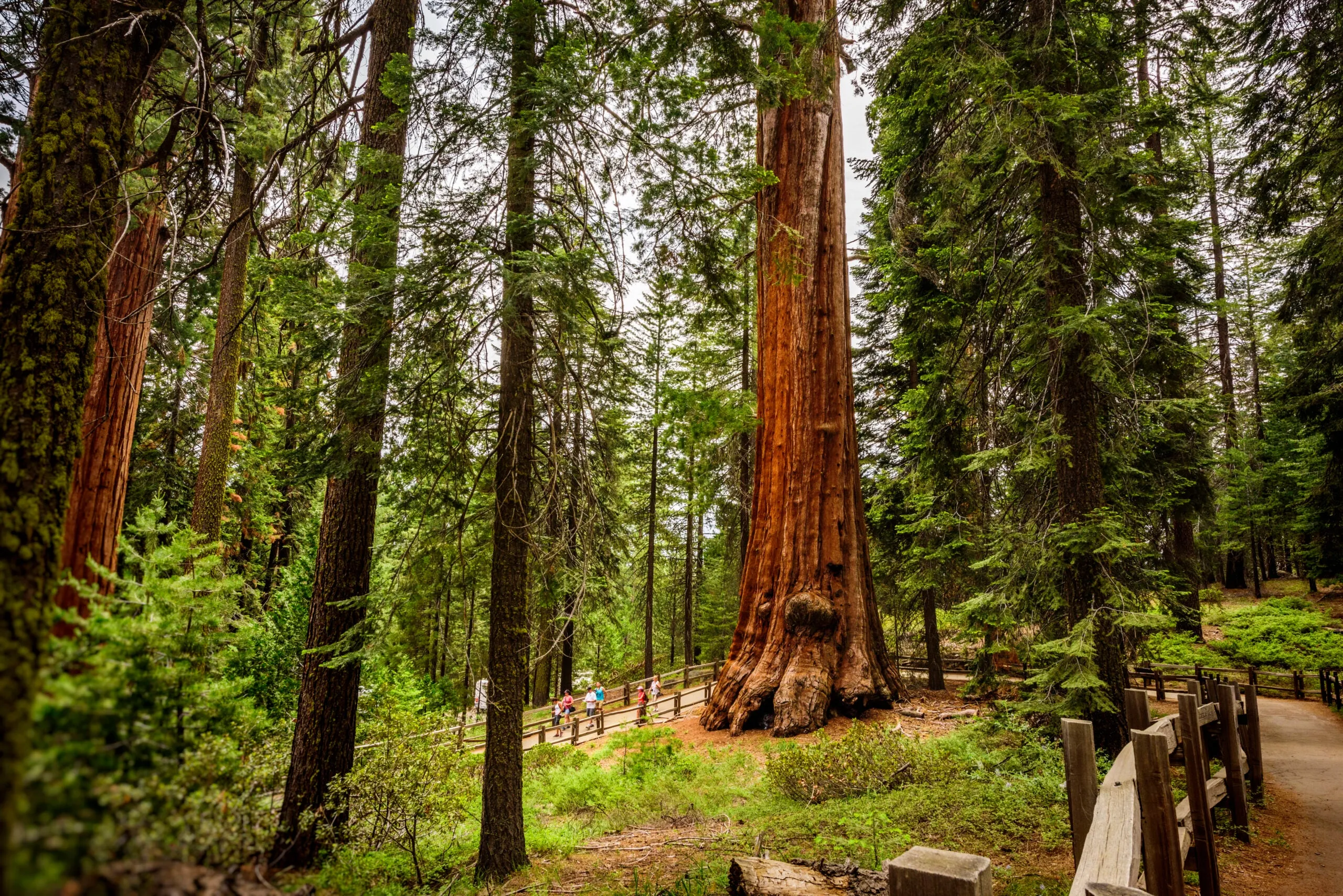 The base of the General Grant Tree a massive giant sequoia in Kings Canyon National Park California
The base of the General Grant Tree a massive giant sequoia in Kings Canyon National Park California
Hike Amidst Ancient Giants and Meadows
When you’re ready to stretch your legs and immerse yourself deeper in the forest, hiking is the perfect way to explore. The scenic 1.3-mile Crescent Meadow Loop trail is an excellent option. This relatively flat loop takes you through a vibrant green meadow often filled with wildflowers during the right season, completely surrounded by towering giant sequoia trees on all sides. It’s a serene and beautiful place to appreciate the scale of the forest giants from ground level.
This area also serves as a central hub for accessing numerous other trails leading deeper into the vast SEKI wilderness. It’s the starting point for the famous High Sierra Trail, a challenging nearly 70-mile one-way trek that connects SEKI to Whitney Portal on the eastern side of the Sierra Nevada mountains. If you have more time during your visit, consider undertaking a longer day hike to explore more of the park’s diverse landscapes, or plan ahead to secure backpacking permits for a multi-day wilderness adventure.
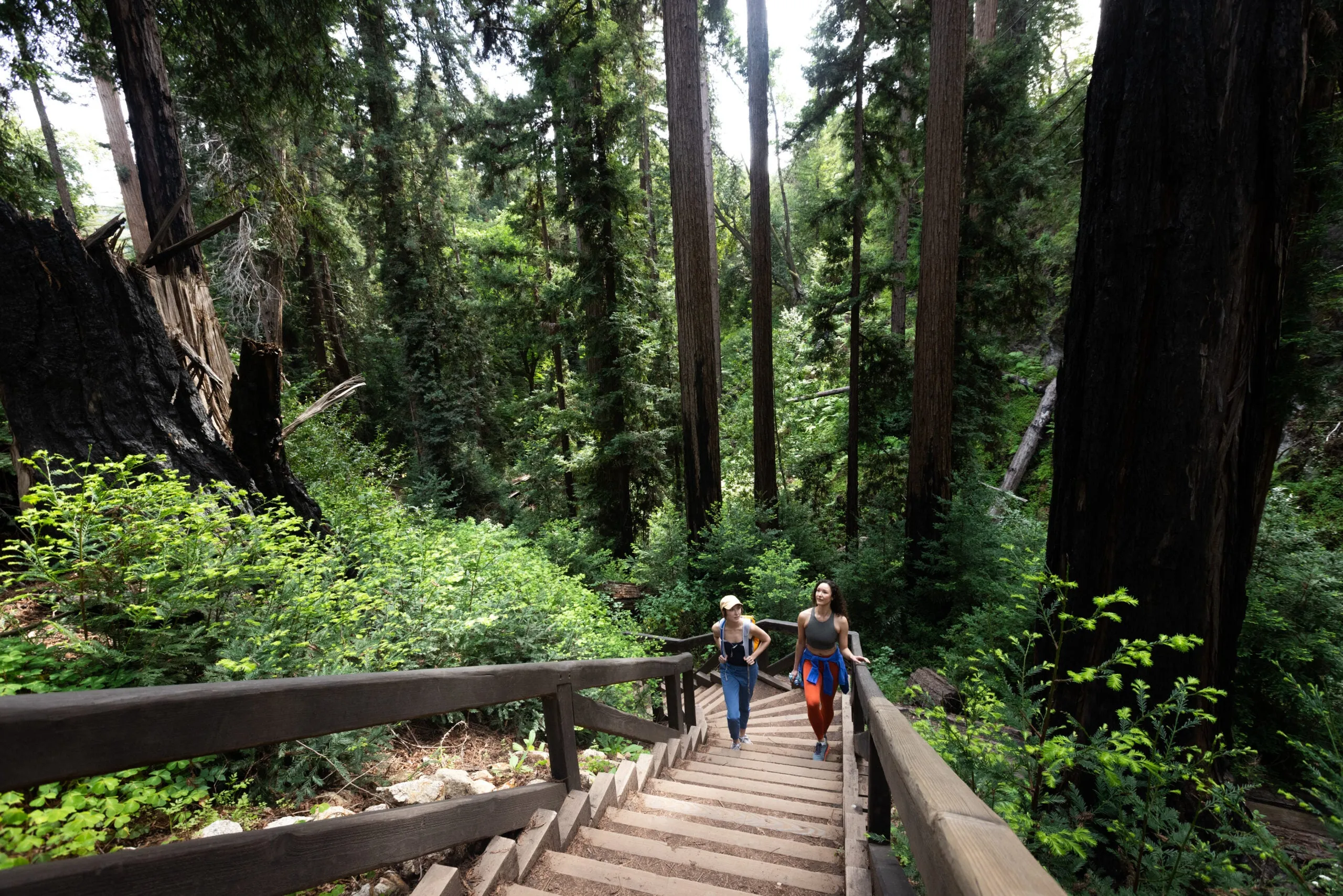 Hikers walking through a grove of giant sequoia trees in Sequoia National Park California
Hikers walking through a grove of giant sequoia trees in Sequoia National Park California
Fresno & SEKI Travel Tip
After a full day of exploring the national parks and the Central Valley, make sure to time your return to the Fresno area for dinner at Trelio Food & Wine in Old Town Clovis. This celebrated local restaurant offers a five-course prix fixe menu that is a true celebration of the region’s agricultural richness. The menu changes daily, designed to feature the freshest, seasonal ingredients sourced directly from local markets, farms, and even foragers. It’s a perfect way to taste the bounty of the Central Valley in a sophisticated and delicious setting.
Frequently Asked Questions about Your California Road Trip
How long does a California Road Trip typically take?
The duration of a California Road Trip can vary greatly depending on the stops and pace. The itinerary described above, covering San Francisco, Monterey, Big Sur, and the Fresno area with a day trip to SEKI, could comfortably be done in 7-10 days, allowing for sufficient time at each location without feeling rushed. However, you could easily extend this to two weeks or more to include additional parks like Yosemite or Death Valley, spend more time in cities, or explore other coastal areas. Plan based on your interests and available time.
What is the best time of year for a California Road Trip?
California offers varied experiences throughout the year. Spring (April-May) brings wildflowers and pleasant temperatures, ideal for hiking and exploring. Summer (June-August) is peak season, perfect for coastal activities and visiting high-elevation parks like Yosemite (though they can be crowded). Fall (September-October) offers stable weather, beautiful autumn colors in the mountains, and opportunities to see monarch butterflies on the coast. Winter (November-March) brings rain to the coast and snow to the mountains, suitable for skiing/snowboarding and viewing dramatic coastal storms, but requires caution with road closures (like parts of Highway 1 or park roads).
What should I pack for a California Road Trip?
Packing for a California Road Trip means preparing for diverse climates and activities. Essential items include layers of clothing (temperatures can change rapidly), comfortable walking or hiking shoes, swimwear (for coast or hotel pools), rain gear (depending on the season), sunscreen, a hat, and sunglasses. If you plan on specific activities like diving or paddleboarding, bring or plan to rent necessary gear. Don’t forget reusable water bottles, a camera, and chargers for electronics.
This California Road Trip offers an incredible journey through diverse landscapes, from vibrant cities to ancient forests and dramatic coastlines. It’s an invitation to not just visit, but to truly experience the heart and soul of the Golden State, connecting with its nature, culture, and history along the way.
